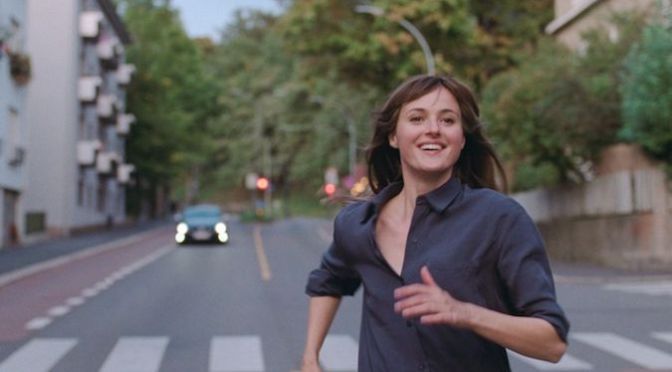All good film is probably about balance in some sense, but it takes a particularly special work of cinema to strike the balance at the heart of The Worst Person in the World. The last installment of Joachim Trier’s loose “Oslo Trilogy” — which also includes Reprise (2006) and Oslo, August 31st (2011) — is connected to its predecessors mostly by the city of Oslo and a few recurring actors, rather than being linked in story or character. But the comedic youthfulness of Part 1 and the dramatic maturity of Part 2 dovetail beautifully here in Part 3, so perhaps that’s the real connective tissue. The Worst Person in the World has moments of genuine hilarity and moments of crushing sadness, but it never slips off that tonal tightrope between the two.
At the start, we’re pretty firmly in romantic comedy territory. Julie (Renate Reinsve) is a young medical student without much passion in her life, so she jettisons her designs on becoming a doctor and decides psychology is more her thing; it’s easier to be passionate about the mind than about the body, after all. She meets a guy and they hook up, and Julie then decides that photography, actually, is a better career fit. She buys camera equipment, takes portraits for a male model, and then hooks up with him. They’re at a bar in the next scene when Julie meets another guy, Aksel (Anders Danielsen Lie), a moderately-famous cartoonist, and before the movie actually really begins Julie and Aksel are together for what feels like the long haul.
That opening is zippy as hell, with omniscient voiceover narration carrying us through this indeterminate period of Julie’s early thirties (as a subtle timestamp, her changing hairstyles let us know she’s hopping from lover to lover within a respectable period, depending on your definition of respectable). As The Worst Person in the World progresses, though, any rom-com predictability one might have sensed in the opening minutes slowly evaporates. Julie and Aksel laugh with each other and fight with each other, yes, but the film is never really rooted in the question of whether these two lovers will end up together or not. Hiding beneath the verve of the film’s prologue is a clear theme around Julie’s feeling of not having a place in the world, iterated in her skating from profession to profession and lover to lover, and the film’s soul shines more brightly through that lens rather than the staid romance of so many similarly-minded movies.
So later in the film, long after Julie’s broken it off with Aksel and moved in with Eivind (Herbert Nordrum), she runs into an old friend of Aksel’s who lets her know that he’s been diagnosed with late-stage terminal cancer. She returns to Aksel as a friend, essentially watching him die slowly, and the pair reflect on their time together. During this stretch Julie’s also pregnant by Eivind, but her feelings about motherhood and sharing the rest of her life with Eivind are as complex as they’ve ever been. By the film’s end Aksel has passed, Julie has had a miscarriage and Eivind has a child with another woman.
…which all seems a long way away from the funny, fast-paced movie promised to us by the prologue, no? And yet somehow it works, not as a slow descent into seriousness but as a deft toggle from humor to drama and back again, over and over, sometimes in the space of a single scene. Julie’s tearful, destructive decision to break up with Aksel is interrupted as time literally freezes, only Julie able to move as she darts through Olso to find Eivind. Passing two frozen lovers kissing in the park, she doubles back to move the woman’s hand onto the man’s butt, winking at the camera before taking off again. But when time resumes a moment later, the breakup is no less painful. That kind of tonal shifting should be jarring, and maybe it is, but it absolutely works as a driving force throughout Trier’s film.
Renate Reinsve probably deserves a lot of credit for this balancing act, because Julie — Reinsve’s first lead role in a feature — is utterly believable both as someone enraptured by the best things in life and terrified of them at the same time. It’s not hard to imagine her as a rom-com star during the most ridiculous moments in The Worst Person in the World, like an awkward bathroom scene or an all-bets-are-off drug trip. But it’s even harder to look away from her in the film’s most dramatic beats, all of Julie’s insecurity and aimlessness manifesting on her face. Trier seems to understand this about his lead actress, keeping the camera largely motionless during the heaviest scenes in another contrast to the quick-cutting comedic sequences. Reinsve rolls with the ever-shifting script without batting an eye, and she’s definitely one to watch in the future.
And Trier is, too, now that his Trilogy is complete, which is not to say that any of the triptych are subpar. But his latest is his best to date, the balancing act of a young master stepping up his craft and taking the kinds of chances rarely seen in anything resembling a romantic comedy. Winks at the camera, dynamic air drumming sessions, conversations about Bambi or the symbolism of a butthole — anyone who can balance these with a thorough investigation of the trauma of adulthood is one with a cleareyed understanding of the medium. The Worst Person in the World will undoubtedly be in the awards conversation this year prior to (hopefully) a wide theatrical U.S. release, and it’s not to be missed.

